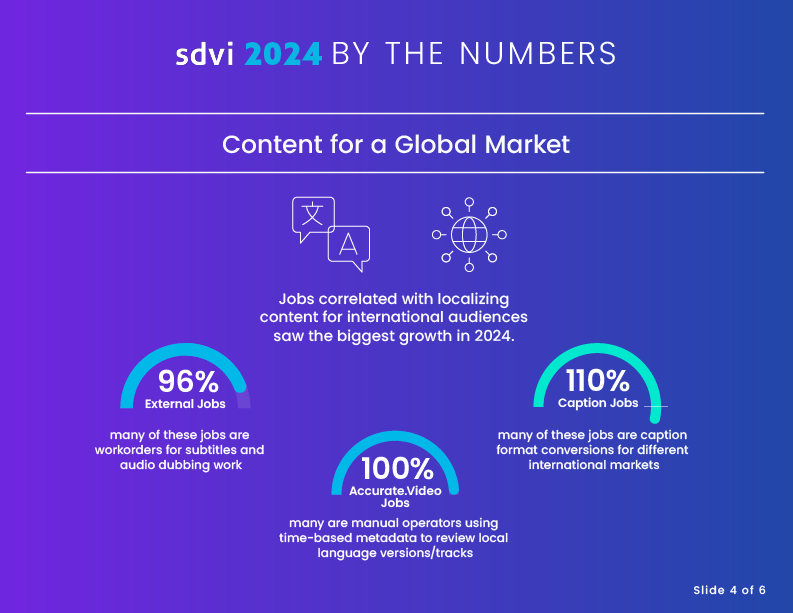At every stage of a media supply chain transformation project, the topic of metadata is perhaps the most consequential. From the earliest analysis and design work to the building and operation of supply chains, knowing what metadata you have, what new metadata to harvest, and how to use it to drive supply chain activity is critical to achieving full optimization.
Media organizations deal with a plethora of metadata as they prepare content for delivery. They receive metadata with incoming content, and they augment that data — manually and often with AI tools, too — as content moves through the supply chain. The better that metadata is, the easier it is for an organization to automate critical tasks, reduce manual intervention, streamline key workflows, and bring greater efficiency to their operations.
Metadata and Its Many Forms
 Metadata is not passive data that just happens to be attached to content; managed well, it becomes active data with tremendous potential to drive decisions. Instructions informed by metadata can trigger specific action within the supply chain to keep content moving forward to delivery. It becomes fuel for the engine that is the supply chain. With effective metadata structuring and governance, an organization can ensure that this engine runs smoothly and efficiently. Let’s take a closer look at various types of metadata in the supply chain and the role they play in driving not just efficiency, but smarter and more agile operations.
Metadata is not passive data that just happens to be attached to content; managed well, it becomes active data with tremendous potential to drive decisions. Instructions informed by metadata can trigger specific action within the supply chain to keep content moving forward to delivery. It becomes fuel for the engine that is the supply chain. With effective metadata structuring and governance, an organization can ensure that this engine runs smoothly and efficiently. Let’s take a closer look at various types of metadata in the supply chain and the role they play in driving not just efficiency, but smarter and more agile operations.
Content Metadata
Metadata about content can arrive with incoming content and be augmented as content is processed and transformed for delivery. This metadata often includes information such as title, cast and crew, synopsis, tags, and genre; language tracks, captions and placement; and additional detail such as notes from the script supervisor, director’s circle takes, and slate and take information. With this depth of content metadata, media organizations can more easily manage, prepare, and monetize all media assets — and facilitate vital downstream activities such as personalization and content discovery.
Technical Metadata
In today’s media world, all content going through a media supply chain will be encapsulated in files, which are created through a process involving choices about frame rate, codec, resolution, aspect ratio, and other technical details. This information, often referred to as technical metadata, is needed to guide systems throughout the entire supply chain on how to process, play back, and even display the content. Technical metadata is critical to the efficient and accurate processing of content by tools in the supply chain that need to reformat or otherwise manipulate the content into something new.
Business Metadata
Typically generated by systems external to the media supply chain management platform, systematized metadata basically describes how content can be used. It includes scheduling information, rights information, and marketing information — even details about poster art, for example. Business metadata also includes order information needed to guide operational behavior. These orders serve as placeholders for content yet to be received, identify the window of time in which it must be delivered, and inform the organization as it prioritizes processing and resource allocation. Media organizations migrating to a cloud-based supply chain may need to reconcile metadata from dozens of systems, each with their own parochial approach to maintaining metadata. While this metadata won’t necessarily be stored in a media supply chain platform, the platform will use this metadata to guide job prioritization and package assembly jobs in an automated fashion. Indicating the type of content and its destination, such metadata also can guide the selection and implementation of the right tool for each job. The goal might be cost savings or achieving the specific functionality required to deliver content that meets the requirements of its destination.
Supply Chain/Workflow Metadata
Supply chain metadata generated by each step in the process can be aggregated not only for reporting and visibility purposes, but also to feed a supply chain decision engine so that future actions can be executed. Enabling automation based on the results of the previous step or process, this type of metadata contributes to a more dynamic and efficient workflow. Supply chain metadata can provide insights into the management and performance of media operations. Based on information captured as content is pushed through the media supply chain, this type of metadata also supports visualization and reporting on factors such as the time or cost to process a piece of content, failure rates, and other performance factors that can be analyzed to understand and then improve the media supply chain.
Time-Based Metadata
A combination of supply chain metadata and content metadata, time-based metadata (TBMD) connects information about content to that piece of media on a temporal basis. In short, it describes points of interest in a media asset. And based off that metadata, added manually or by a QC or AI tool, further steps in the media supply chain can be triggered — some automatically and others with human insight and intervention. With tools that can present TBMD on the operator’s interface, work can be more directed and specific, enabling operators to perform their work faster and with more accuracy.
Making the Most of Metadata
 All those categories and sources! With the capacity to capture all this information and react in response to it, an organization can drive exponential improvements in efficiency. (Our recent press release on A+E Networks EMEA is a great example.) Developing a governance strategy and a schema for metadata is a critically important element of the journey to the cloud. When applied not just to incoming content, but also to an organization’s archive, this work drives wide-ranging supply chain optimization and presents an opportunity to extract and normalize valuable content metadata from existing assets.
All those categories and sources! With the capacity to capture all this information and react in response to it, an organization can drive exponential improvements in efficiency. (Our recent press release on A+E Networks EMEA is a great example.) Developing a governance strategy and a schema for metadata is a critically important element of the journey to the cloud. When applied not just to incoming content, but also to an organization’s archive, this work drives wide-ranging supply chain optimization and presents an opportunity to extract and normalize valuable content metadata from existing assets.
Equally important to developing a metadata strategy is being able to support different types of metadata for different types or classes of content. For example, movie content might have a different metadata schema than promos or episodic material. Your metadata strategy, and the platforms you use to manage your supply chain, should be flexible enough to support any and all types of metadata for your content. It’s important not to get locked into a single metadata schema for all your different types of content.
Ideally, metadata structuring is a precursor to building a high-performance supply chain. It eliminates the need to convert, adapt, and translate fresh metadata with every piece of content received. Rather than deal with multiple sources of truth — which can amount to dozens of metadata sources from different ordering systems, MAM systems, and other systems acquired over time or through acquisitions — the organization can work with normalized data and a single source of truth.
Another important benefit of having a metadata strategy in place is that it facilitates metadata mapping between business partners and their metadata schemas to simplify the exchange of content (and its metadata) between businesses. The sender can transform the metadata to match the recipient’s model — a process that can happen automatically — and, in turn, substantially reduce the need to recreate or replace vital metadata. An exchange based on trusted metadata mapping can, for example, provide the recipient with metadata from the sender’s final QC report. As a result, the recipient can narrow subsequent QC to a much smaller set of key factors, reducing duplication for both time and cost savings.
Utilizing systems that create, store, modify, and exchange metadata using accessible, interchangeable methods is crucial to supply chain efficiency. First, open systems facilitate data interoperability, allowing different systems to exchange and integrate information while enabling collaboration and efficiency across diverse platforms and organizations. Additionally, it promotes data longevity and usability, as metadata stored in open systems can be easily accessed and understood over time, regardless of technological changes.
While perfect mapping of every single piece of metadata up front is the Holy Grail of metadata management, the process doesn’t need to be perfect on Day 1 of your migration. What’s more important? Just getting started. With a media supply chain management platform like Rally, your organization can undertake metadata normalization while maintaining the flexibility to adapt as the business evolves and new metadata sets from other essential business systems need to be harmonized. The sooner you begin this process and shift to the cloud, the sooner you can begin leveraging this wealth of metadata to transform your operations and business.
—
Imagine all the ways that optimized metadata management could drive more efficient and intelligent operations for your business. Get in touch, and we’ll show you!



